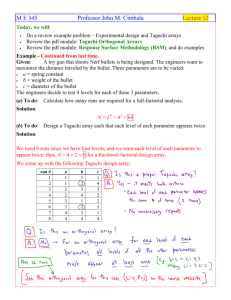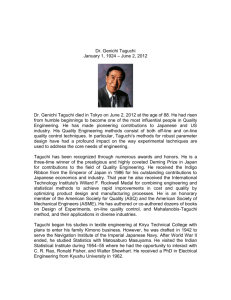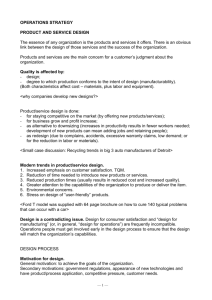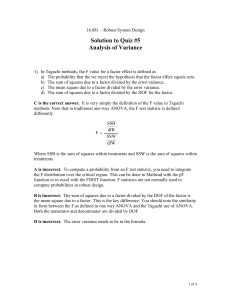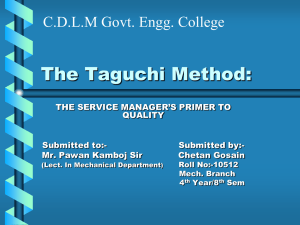Taguchi and ANOVA Analysis of Deburring Process Parameters of PP Mat
advertisement
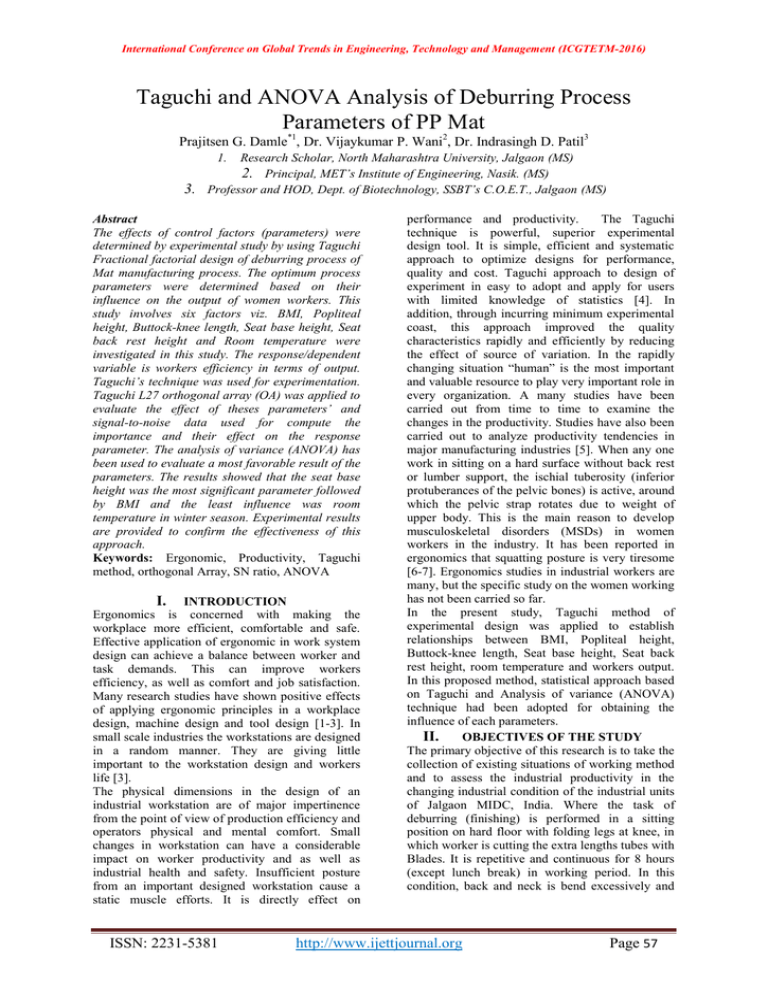
International Conference on Global Trends in Engineering, Technology and Management (ICGTETM-2016) Taguchi and ANOVA Analysis of Deburring Process Parameters of PP Mat Prajitsen G. Damle*1, Dr. Vijaykumar P. Wani2, Dr. Indrasingh D. Patil3 1. 3. Research Scholar, North Maharashtra University, Jalgaon (MS) 2. Principal, MET’s Institute of Engineering, Nasik. (MS) Professor and HOD, Dept. of Biotechnology, SSBT’s C.O.E.T., Jalgaon (MS) Abstract The effects of control factors (parameters) were determined by experimental study by using Taguchi Fractional factorial design of deburring process of Mat manufacturing process. The optimum process parameters were determined based on their influence on the output of women workers. This study involves six factors viz. BMI, Popliteal height, Buttock-knee length, Seat base height, Seat back rest height and Room temperature were investigated in this study. The response/dependent variable is workers efficiency in terms of output. Taguchi’s technique was used for experimentation. Taguchi L27 orthogonal array (OA) was applied to evaluate the effect of theses parameters’ and signal-to-noise data used for compute the importance and their effect on the response parameter. The analysis of variance (ANOVA) has been used to evaluate a most favorable result of the parameters. The results showed that the seat base height was the most significant parameter followed by BMI and the least influence was room temperature in winter season. Experimental results are provided to confirm the effectiveness of this approach. Keywords: Ergonomic, Productivity, Taguchi method, orthogonal Array, SN ratio, ANOVA I. INTRODUCTION Ergonomics is concerned with making the workplace more efficient, comfortable and safe. Effective application of ergonomic in work system design can achieve a balance between worker and task demands. This can improve workers efficiency, as well as comfort and job satisfaction. Many research studies have shown positive effects of applying ergonomic principles in a workplace design, machine design and tool design [1-3]. In small scale industries the workstations are designed in a random manner. They are giving little important to the workstation design and workers life [3]. The physical dimensions in the design of an industrial workstation are of major impertinence from the point of view of production efficiency and operators physical and mental comfort. Small changes in workstation can have a considerable impact on worker productivity and as well as industrial health and safety. Insufficient posture from an important designed workstation cause a static muscle efforts. It is directly effect on ISSN: 2231-5381 performance and productivity. The Taguchi technique is powerful, superior experimental design tool. It is simple, efficient and systematic approach to optimize designs for performance, quality and cost. Taguchi approach to design of experiment in easy to adopt and apply for users with limited knowledge of statistics [4]. In addition, through incurring minimum experimental coast, this approach improved the quality characteristics rapidly and efficiently by reducing the effect of source of variation. In the rapidly changing situation “human” is the most important and valuable resource to play very important role in every organization. A many studies have been carried out from time to time to examine the changes in the productivity. Studies have also been carried out to analyze productivity tendencies in major manufacturing industries [5]. When any one work in sitting on a hard surface without back rest or lumber support, the ischial tuberosity (inferior protuberances of the pelvic bones) is active, around which the pelvic strap rotates due to weight of upper body. This is the main reason to develop musculoskeletal disorders (MSDs) in women workers in the industry. It has been reported in ergonomics that squatting posture is very tiresome [6-7]. Ergonomics studies in industrial workers are many, but the specific study on the women working has not been carried so far. In the present study, Taguchi method of experimental design was applied to establish relationships between BMI, Popliteal height, Buttock-knee length, Seat base height, Seat back rest height, room temperature and workers output. In this proposed method, statistical approach based on Taguchi and Analysis of variance (ANOVA) technique had been adopted for obtaining the influence of each parameters. II. OBJECTIVES OF THE STUDY The primary objective of this research is to take the collection of existing situations of working method and to assess the industrial productivity in the changing industrial condition of the industrial units of Jalgaon MIDC, India. Where the task of deburring (finishing) is performed in a sitting position on hard floor with folding legs at knee, in which worker is cutting the extra lengths tubes with Blades. It is repetitive and continuous for 8 hours (except lunch break) in working period. In this condition, back and neck is bend excessively and http://www.ijettjournal.org Page 57 International Conference on Global Trends in Engineering, Technology and Management (ICGTETM-2016) postures of different parts of body considerably deviate from neutral. The specific objectives of the study were: 1. To work out productivity of women workers on new workstation. 2. To find out optimum combination of control variable for maximum production. III. METHODOLOGY A. Taguchi Method Taguchi‟s design method is a powerful tool for optimization of the performance characteristic of a process. The aim of a Taguchi design experiment is to identify and design the settings of the process parameters at optimize level in their respective range and are least sensitive to noise factors. Selection of control factors and their levels are made on the basis of some preliminary trial experiments conducted on the basis of single variable at a time and also from literature review. The experiments were based on the basis of orthogonal array technique. Using orthogonal array design the effects of multiple variables on the performance characteristic can be estimated simultaneously while minimizing the number of test runs. Taguchi‟s approach has been built on traditional concept of DOE, such as full factorial, fractional design and orthogonal arrays based on signal to noise ratio, robust design and parameter and tolerance design. It is a powerful tool for designing high quality systems and provides a simple, efficient and systematic approach for optimizing the designs for performance, quality and cost. This method can reduce research and development costs by studying a large number of parameters. Taguchi suggested a standard procedure for optimizing any process parameters. The steps involved are: Identification of the noise factors and test co nditions Identification of the control factors and their alternative levels. Designing the experiment and defining the d ata analysis procedure. Conducting the experiment. Analyzing the data and determining the opti mum levels of control factors. Predicting the performance at these levels. In order to analyze the results, the Taguchi method uses a statistical measure of performance called signal to noise ratio (SN ratio). The SN ratio takes the mean and the variability into account. The SN equation depends on the criteria for the quality characteristic to be optimized. After performing the statistical analysis of SN ratio, ANOVA can be employed in estimation of error variance and to judge the relative importance of the control factors. This allows collection of necessary data for determining factors that are mostly affecting the product quality with a minimum amount of ISSN: 2231-5381 experimentation and thus saving time and resources [8]. a. Analysis of Signal-to-Noise (SN) ratio : In Taguchi method, the term „signal‟ represents the desirable value (mean) for the response and the term „noise‟ represents the undesirable value for the response. Taguchi uses SN ratio to measure the quality characteristic deviating from the desired value. There are several SN ratios available depending on the type of characteristics i.e. Smaller-the-better, Nominal-the-better and Higherthe-better. The formula used for calculating S/N ratio is given below. Smaller the better: - it is used where the smaller value is desired. where y = observed response value and n = number of repetitions. Nominal the better: - it is used where the nominal and variation about that value is minimum. where µ = mean and s = variance. Higher the better: - it is used where the larger value is desired. where y = observed response value and n = number of repetitions The SN ratio is defined as, SN = -10 log (M.S.D.) where M.S.D. is the mean-square deviation for the response characteristic.[9] B. Selection of Orthogonal Array: Techniques of arranging experiments under multiple factors are known as the Factorial DOE. This method helps the researchers in determination of the possible combinations of factors and the identification of the best combination and their levels. However in industrial location it is very costly process to run large number of experiments in testing all combinations. The Taguchi approach describe the plans in carrying out experiments and also standardized the design of the experiment along with minimum number of factor combinations that would be required for testing the influence of factors [10]. C. Analysis of variance (ANOVA) The knowledge of the contribution of individual factors is a key to deciding the nature of the control to be established on a production process. The analysis of variance (ANOVA) is the statistical action most commonly applied to the results of the http://www.ijettjournal.org Page 58 International Conference on Global Trends in Engineering, Technology and Management (ICGTETM-2016) experiment to determine the percent contribution of each factor. Study of the ANOVA table for a given analysis helps to determine which of the factors need control and which do not. Once the optimum condition is determined, it is usually a good practice to run a confirmation experiment. It is, however, possible to estimate performance at the optimum condition from the results of experiments conducted at a non-optimum condition. It should be noted that the optimum condition may not necessarily be among the many experiments already carried out, as the OA represents only a small fraction of all the possibilities. Taguchi suggests two different methods to carry out the complete analysis. First, the standard approach is, where the results of a single run or the average of repetitive runs is processed for ANOVA analysis. The second approach, which he strongly recommends for multiple runs, is to use signal to noise ratio SN for the same steps in the analysis. SN analysis determines the most robust set of operating conditions from variations within the results [11]. IV. EXPERIMENTAL STUDY A preliminary survey was conducted to identify problems in mat manufacturing industries through questionnaire and interviewing of 120 workers. It was found that, due to awkward sitting posture many of the workers had a problem of Musculoskeletal disorder (MSD). It has been reported that, due to sitting on hard surface without back lumber support women worker has many health issue i.e. Low back disorders (LBD) [12]. It affect on their working efficiency directly. For increasing the working efficiency as well as their working position comfortable, researcher applied the Taguchi optimization technique and measures the efficiency of worker in the form of output. This study was conducted in actual field of work in the selected industry. Experimentations were done in three seasons to see the effect of environmental factors with other six control factors. The operation was performed on fixed height table and adjustable chair. The objective of the experiment is to find out optimize the parameters of workstation in order to improve the efficiency of worker. In this study, an experimental method is proposed to fully understand effects of various parameters on efficiency of workers. For this experimentation, 95 women workers are participated. On adjustable experimental workstation, the worker performed their normal deburring task in 27 experimental sessions of 45 min. The set of experiment is the present working conditions. Researcher considers six parameters with three levels as indicated in table 1 for winter season base on one variable at a time method. Once the experimental design has been determined and the trials have been carried out, the measured ISSN: 2231-5381 response from each trial can be used to analyze the relative effect of the different parameters. To demonstrate the data analysis procedure, the L27 array is used and experiment is repeated three times. Mean of response is considered for SN ration calculation. Table1 Parameters and their range & levels (for winter season) Sr. No . Symb ol 1 V. Paramete rs Rang e A: BMI Wi 2 L1 3 L2 4 H1 5 H2 6 Rt B: Buttock knee length C: Popliteal height D: Seat base height E: Backrest middle height from seat base G: Room temperatu re Lev el 1 Level Lev el 2 Lev el 3 13.7 931.4 7 13 19 19 25 25 31 383 419 380 -394 394 408 408 422 490 600 380 -520 520 560 560 -600 380 – 560 380 470 560 100 200 100 150 200 22 32 22 27 32 RESULTS AND DISCUSSION A. Taguchi Method The results of this research are based on the case study conducted on the production line of the PP Mat manufacturing industry. One of the hypothesis is the efficiency of worker has a direct relation with setting position and BMI, buttock-knee length, popliteal height, seat base height, back rest height and room temperature. SN ratios are calculated for each factor and level; they are tabulated as shown below in table 2. Taguchi recommends analyzing the mean and SN ratio using a conceptual approach that involves graphing the effect and visually identifying the factor that appear to be important, without using ANOVA. The SN ration graphs are shown in figure no. 1. Table 2 Response Table for S/N Ratios for winter season (Larger is better) Level A B C D E F 1 36.87 37.18 37.45 37.04 37.52 37.55 2 37.68 37.66 37.09 38.05 37.53 37.39 3 37.82 37.53 37.83 37.28 37.32 37.44 Delta 0.95 0.48 0.74 1.01 0.24 0.24 Rank 2 4 3 1 5 6 http://www.ijettjournal.org Page 59 International Conference on Global Trends in Engineering, Technology and Management (ICGTETM-2016) Sour ce D F Adj SS Adj MS FValu e A 2 377.2 172.1 1 5.48 B 2 64.67 32.33 0.75 C 2 193.6 96.78 2.57 D 2 384.2 192.1 1 6.45 E 2 20.67 10.33 0.23 F 2 9.56 4.778 0.11 Error 14 -- -- Total 26 48.8 1098. 7 PValu e 0.01 1 0.48 3 0.09 8 0.00 6 0.79 6 0.90 0 -- -- -- -- contributi on 34.33 5.88 17.62 35.00 Figure 1 Main Effect Plot between SN ratios of each parameters and level (for winter season) From the table 3 it is clear that, the P-value (0.006) of seat base height is significantly contributing towards productivity. ANOVA results closely match with Taguchi result. Table 3 one way analysis of variance 1.88 0.87 4.42 100 From the response graph it can be seen that factor D has larger effect on the performance. Factor F has a relatively small effect. Since a response variable is the maximum output, this implies that the quality characteristics type is a Larger-thebetter. The difference between the highest and the lowest values represent the significance of a factor; a ranking is done on all the factors. From response table 2, the highest value of each SN ratio for each factor can be identified clearly as well as most dominating factor is identified. The highest value of each SN ratio for each factor is used to form optimum combination of level of each factor. The larger the deltas (Δ) value for a parameter, the larger the effect the variable has on the process. This implies that factors D, A, and C are more important than the rest of the factors. This is because the same change in signal causes a larger effect on the output variable being measured. B. Analysis of Variance Effect of individual parameters on entire process and their percentage contribution of individual parameters can be well determined using ANOVA. MATHEMATICA software of ANOVA module was employed to investigate effect of process parameters. The frequency test (F-test) is utilized in statistics to analyze the significant effects of the parameters, which form the quality characteristics. Table 3 shows the result of ANOVA analysis of SN ratio for productivity. This analysis was carried out ISSN: 2231-5381 for a level of significance of 95% confidence. The last column of the table shows the contribution of each factor in percent as the total variation, indicating its influence on the result. Figure 2 shows the contribution of each parameter on the productivity in percentage. It is demonstrated that seat base height has the most significant effect on the output response i.e. productivity. Other significant parameters are BMI and Popliteal height. contribution A 2% 1% B 36% 37% C D 18% E 6% Figure 2 relative effect of each parameter on productivity (%) C. Verification Test By statistical analysis, optimum level of parameters are; A3 B2 C3 D2 E2 F1. Most influencing parameter is seat base height, which gives most significant effect to productivity. VI. CONCLUSIONS In this study, the Taguchi method provides a systematic and efficient methodology for the design and optimization of control parameters. The data analysis was performed by Taguchi method in MINITAB statistical software, the optimum relationship between parameters and levels are obtained. The optimum level of parameter has been obtained with respective the experimental period i.e. A3 B2 C3 D2 E2 F1 for winter period. The result might vary for test carried out in different industry. ANOVA results closely match with Taguchi result. REFERENCES 1. M. Shaliza, K. Shahrul, M. Mohzani, O. Zalinda and S. Khairanum, 2006 “Application of Quality Function Deploy- ment in Identifying Ergonomics Programs for Malaysian, The Effect of Ergonomics Applications in Work System on Mental Health of Visual Display Terminal Workers Manufacturing Industries,” Proceedings in International Conference on Technology Management, 4-5 December 2006, http://www.ijettjournal.org Page 60 F International Conference on Global Trends in Engineering, Technology and Management (ICGTETM-2016) 2. 3. 4. 5. 6. 7. 8. 9. 10. 11. 12. 13. 14. 15. University of Technology Tun Hussien Onn, Malaysia, pp. 275-277. Armstrong, T. J., Radwin, R. G., Hansen, D. J. and Kennedy, K. W. 1986 “Repetitive trauma disorders: Job evaluation and design” Human Factors 28: 325336. Das, B. and Grady, R. M. 1983. “Industrial workplace layout design: An application of engineering anthropometry”. Ergonomics 26: 433447. P. J. Ross, Taguchi Techniques for Quality Engineering, McGraw- Hill, New York, 1998. Heizer,Jay, Render Barry, (1999), Operations Management, Prentice-Hall, Int. New Jersey. Biman Das, Julia Wimpee, Bijon Das. “Ergonomics evaluation and redesign of a hospital meal cart”, Applied Ergonomics, Vol. No. 33,pp. 309-318, 2002. Murrel K.F.H. Ergonomics man in his working environment, Publisher: Chapman and Hall Ltd, Fifth Edition 1965. Gautam V., 2014, Optimization of process parameters for gas tungsten arc welding of AA1100 aluminum alloy, International Journal of Current Engineering and Technology, Vol. 4, No.2, pp. 788792. Çiçek A., Kıvak T., Ekici E. 2013. “Optimization of drilling parameters using Taguchi technique and response surface methodology (RSM) in drilling of AISI 304 steel with cryogenically treated HSS drills” Journal of International Manufacturing, DOI: 10. 1007/s10845-013-0783-5. Bendell A., Disney J., Pridmore W.A. (eds.) 1989. Taguchi Methods- Applications in World Industry, IFS series. Farhad Kolahan1, Mohsen manoochehri2, Abbas Hosseini3, “Application of Taguchi Method and ANOVA Analysis for Simultaneous Optimization of Machining Parameters and Tool Geometry in Turning” World Academy of Science, Engineering and Technology 74 2011. Dhananjay Ikhar1, Vishwas Deshpande2 & Sachin Untawale3, “Work Related Musculoskeletal Disorders in Cotton Spinning Occupation: An Ergonomic Intervention” International Journal on Theoretical and Applied Research in Mechanical Engineering (IJTARME), Volume-2, Issue-4, 2013. Ismail, A.R., Rani, M.R.A., Makhbul, Z.K.M. and Deros, B.M. 2008, “Relationship of relative humidity to productivity at a Malaysian electronics industry” Journal of Mechanical Engineering. 5(2): 63-72. Shikdar, A.A. and Sawaqed, N.M. 2003. “Worker productivity, and occupational health and safety issues in selected industries” Computers and Industrial Engineering, 45(4): 563-572. Yazdani, A., Anita, A.R., Hayati, K.S. and Adun, M.Y. 2009 “Association between awkward posture and musculoskeletal symptom among automobile assembly line workers in Malaysia” Proceedings of the National Symposium on Advancements in Ergonomics and Safety (ERGOSYM), pp. 28-32. ISSN: 2231-5381 http://www.ijettjournal.org Page 61
